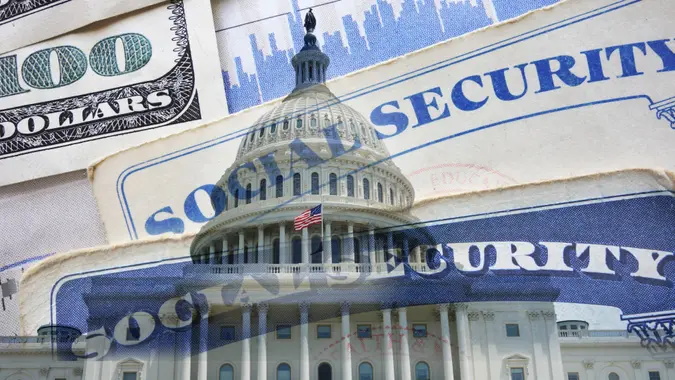Advertiser Disclosure
GOBankingRates works with many financial advertisers to showcase their products and services to our audiences. These brands compensate us to advertise their products in ads across our site. This compensation may impact how and where products appear on this site. We are not a comparison-tool and these offers do not represent all available deposit, investment, loan or credit products.
1 in 5 People Are Retired in These States — Here Is What Retirement Costs Them in 2025
 Written by
T. Woods
Written by
T. Woods
 Edited by
Chris Cluff
Edited by
Chris Cluff

Commitment to Our Readers
GOBankingRates' editorial team is committed to bringing you unbiased reviews and information. We use data-driven methodologies to evaluate financial products and services - our reviews and ratings are not influenced by advertisers. You can read more about our editorial guidelines and our products and services review methodology.

20 YearsHelping You Live Richer

Reviewed by Experts

Trusted by Millions of Readers
In America, there are currently 11 states in which at least 20% of the population (approximately one in five residents) is retired. Some of these states are bastions of retirement thanks to their natural beauty; others are, quite simply, just more affordable. Whatever the reasons, these are the most retirement-heavy states in the union, and that begs the question: Just how much does it cost to retire there?
That’s a question GOBankingRates sought to answer in a recent study. For each state in which at least 20% of the population is age 65 and older, GOBankingRates analyzed the household median income, overall cost of living, the average Social Security income for individuals and couples, and more. From that data, GOBankingRates was then able to determine what retirement costs in the states with the highest retirement populations in the country.
Additionally, GOBankingRates sourced each state’s overall cost of living from the Missouri Economic Research and Information Center (MERIC). An index value above 100 represents a state that is more expensive than the national average, and a value below 100 represents a cost-of-living index below that national average.
Ranked from the highest 65-and-older population to the lowest, these 11 states are the go-to destinations for America’s retirees — and this is how much they’ll cost you in your golden years.
1. Maine
- % of population 65+: 23.5%
- Monthly cost of living for single person (after Social Security): $3,460
- Monthly cost of living for couple (after Social Security): $2,505
With a cost-of-living index of 113.4, Maine has the 10th-highest cost of living in the nation. While grocery prices are close to the national average, its housing costs can be dizzyingly high. However, the Pine Tree State more than makes up for those high costs with a lush natural beauty that mixes wooded areas with rocky coastlines.
2. Vermont
- % of population 65+: 22.9%
- Monthly cost of living for single person (after Social Security): $3,474
- Monthly cost of living for couple (after Social Security): $2,520
Vermont is another rather pricey state, coming in eighth in terms of highest cost of living in America with an index score of 113.7. Housing, utility and healthcare costs are all fairly high here.
View More: I Asked ChatGPT What Trump’s Big Beautiful Bill Means for Retirees’ Taxes: Here’s What It Said
3. West Virginia
- % of population 65+: 21.9%
- Monthly cost of living for single person (after Social Security): $2,264
- Monthly cost of living for couple (after Social Security): $1,309
Retirees wanting to save should consider West Virginia as a place to settle down. With a COL index of 88.6, it’s one of the five most affordable states in the union.
4. Florida
- % of population 65+: 21.8%
- Monthly cost of living for single person (after Social Security): $2,910
- Monthly cost of living for couple (after Social Security): $1,955
Thanks to its balmy subtropical climate and beautiful beaches, Florida is known as a retirement haven. It’s also a relatively affordable one in terms of overall cost of living: The Sunshine State has an index score of only 102.
5. Delaware
- % of population 65+: 21.7%
- Monthly cost of living for single person (after Social Security): $2,983
- Monthly cost of living for couple (after Social Security): $2,028
The First State’s cost of living is 3.5% higher than average, giving it the 17th-highest cost of living in America. Not a bad price to pay for lovely Atlantic beaches, rolling hillsides and abundant nature preserves.
6. Hawaii
- % of population 65+: 21.5%
- Monthly cost of living for single person (after Social Security): $6,782
- Monthly cost of living for couple (after Social Security): $5,828
There’s no doubt about it, retiring on a beautiful Pacific island state comes at a high cost — the highest cost, in fact, in terms of the cost-of-living index. Hawaii has an index value of 182.3, the highest cost of living in America by far (for context, the next-highest state on the index is Massachusetts, with a value of 145.1).
7. New Hampshire
- % of population 65+: 21.5%
- Monthly cost of living for single person (after Social Security): $3,301
- Monthly cost of living for couple (after Social Security): $2,346
While New Hampshire’s cost of living index is 110.1, specific costs in the state vary wildly. Groceries there are cheaper than the national average, while utilities are much more expensive.
8. Montana
- % of population 65+: 21.2%
- Monthly cost of living for single person (after Social Security): $2,640
- Monthly cost of living for couple (after Social Security): $1,685
Montana is one of the cheaper go-to retirement states, with a cost of living about 4% cheaper than average. While grocery and health care costs there are significantly higher than the rest of country, Montana’s housing and utility costs are extremely low when compared to the national averages.
9. Pennsylvania
- % of population 65+: 20.4%
- Monthly cost of living for single person (after Social Security): $2,693
- Monthly cost of living for couple (after Social Security): $1,738
The Keystone State ranks 25th overall in cost of living, with a value of 97.5. Groceries, healthcare and housing are all cheaper than the rest of the nation. Conversely, its utility and transportation costs are quite high.
10. New Mexico
- % of population 65+: 20.1%
- Monthly cost of living for single person (after Social Security): $2,534
- Monthly cost of living for couple (after Social Security): $1,579
New Mexico’s MERIC index of 94.2 indicates a quite low cost of living when compared to the rest of the United States. It’s a place where everything but healthcare is cheaper than the national average.
11. Wyoming
- % of population 65+: 20%
- Monthly cost of living for single person (after Social Security): $2,669
- Monthly cost of living for couple (after Social Security): $1,714
Wyoming rounds out the 11 states with a 65-and-older population of 20% or more, and it does so with a COL index of 97. It’s an affordable state to spend your golden years, with only grocery costs rising just slightly above the national average.
More From GOBankingRates
Share This Article:




You May Also Like


5 Cities Where You Can Retire for $1,500 a Month and Enjoy All 4 Seasons
November 21, 2025
6 min Read

I Asked ChatGPT Where To Retire on $1,500/Month -- It Named 5 Wonderful Cities
November 19, 2025
6 min Read

I'm Retired and Regret Not Taking Social Security at Age 62 -- Here's Why
November 20, 2025
6 min Read


How Trump's Policies Are Quietly Reshaping Your Retirement Plans for 2026
November 21, 2025
6 min Read

Annuities, Bonds, and CDs: How They Compare as Retirement Income Streams
November 21, 2025
6 min Read

7 Most Effective Retirement Planning Moves of 2025 You Should Take Into 2026
November 19, 2025
6 min Read

Social Security Just Made a Major Change: Act Now To Protect Your Retirement
November 21, 2025
6 min Read

3 Ways the Trump Administration Is Changing Social Security in the Next 3 Years
November 21, 2025
6 min Read

I'm a Boomer: 3 Things I Wish I'd Done Differently To Prepare for Retirement Longevity
November 19, 2025
6 min Read


Retirement 2026 and Beyond: What the New 4.7% Rule Looks Like for Spending
November 20, 2025
6 min Read

- How Long Will My Money Last?
- How Much Do You Need To Retire?
- How To Prepare For Retirement
- How To Save For Retirement Without A 401K
Learn More About Early Retirement Planning
Make your money work for you
Get the latest news on investing, money, and more with our free newsletter.
By subscribing, you agree to our Terms of Use and Privacy Policy. Unsubscribe at any time.


Thanks!
You're now subscribed to our newsletter.
Check your inbox for more details.



Sending you timely financial stories that you can bank on.
Sign up for our daily newsletter for the latest financial news and trending topics.
For our full Privacy Policy, click here.
Looks like you're using an adblocker
Please disable your adblocker to enjoy the optimal web experience and access the quality content you appreciate from GOBankingRates.
- AdBlock / uBlock / Brave
- Click the ad blocker extension icon to the right of the address bar
- Disable on this site
- Refresh the page
- Firefox / Edge / DuckDuckGo
- Click on the icon to the left of the address bar
- Disable Tracking Protection
- Refresh the page
- Ghostery
- Click the blue ghost icon to the right of the address bar
- Disable Ad-Blocking, Anti-Tracking, and Never-Consent
- Refresh the page




